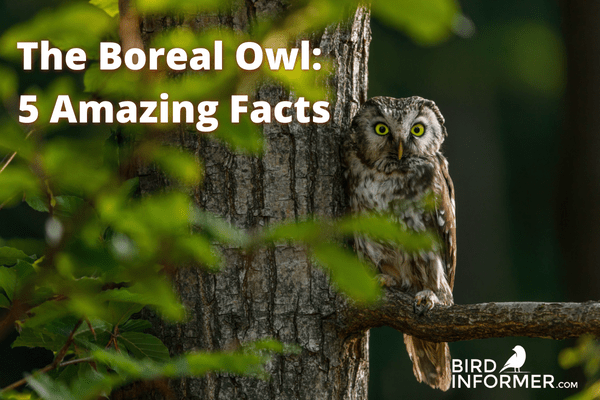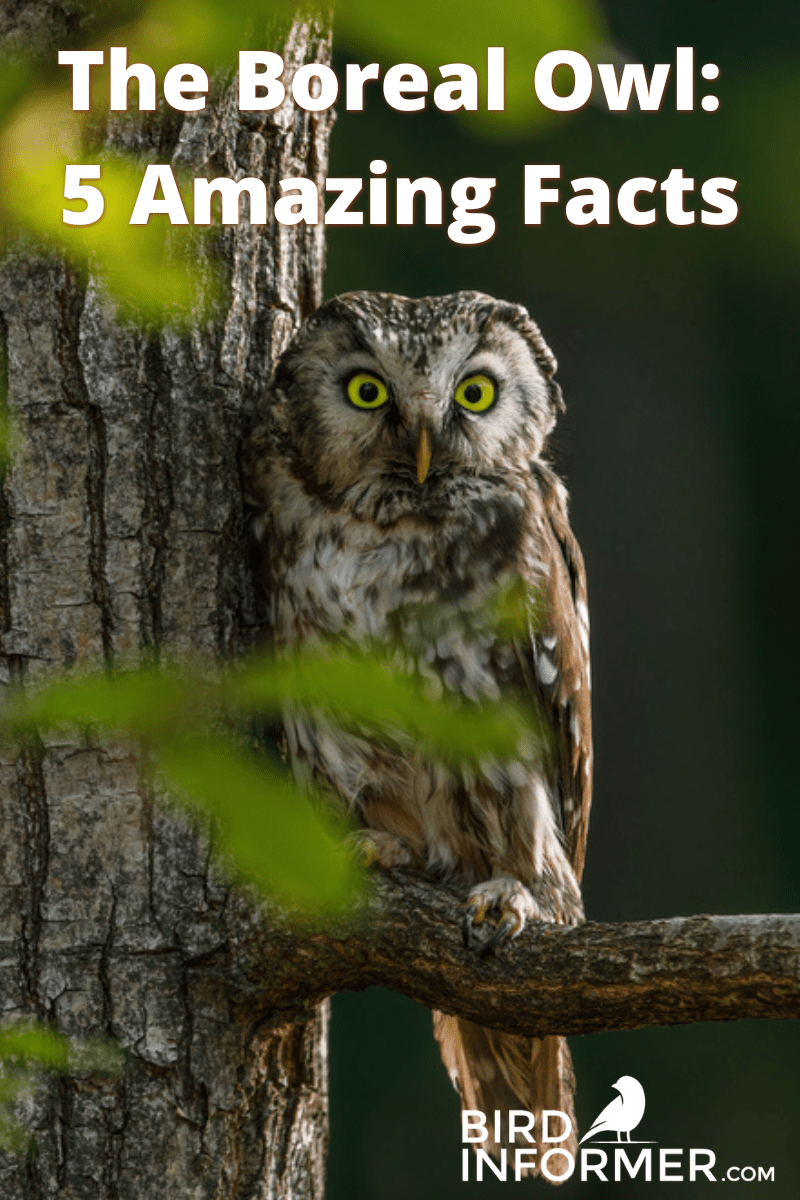Contents [show]
The boreal owl has a number of other common names including sparrow owl, Richardson’s owl, Tengmalm’s owl, Arctic saw-whet, and funeral owl.
This small owl doesn’t possess any ear tufts as many other owls do. The female and male members of the species both have very similar plumage.
Generally, the upper parts of the boreal owl are dark brown. The backside of the owl possesses large white spots. It has a thickly spotted crown with lots of small white spots adorning it. And the owl also has a white facial disk that has dark brown borders going along the sides.
I’d also like to share a number of other important facts about boreal owls. The topics that I’ll cover in greater detail include:
- Properly identifying boreal owls
- Fun and interesting facts about them
- The differences (if any) between female and male boreal owls
- Behaviors and habits including nesting habits, migratory habits, feeding behaviors, and nesting behaviors
- Other critical facts about these beautiful hooting creatures of the night
Learn all this and more by continuing to read below.
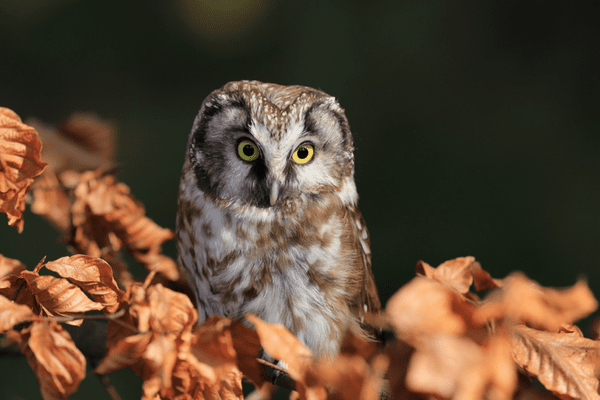
Boreal owl facts
- Common Name: Boreal Owl
- Scientific Name: Aegolius funereus
- Scientific Family: Strigidae
- Life Span: 12-6 years
- Size: 8.7 to 10.6 inches
- Wingspan: 20.0 to 24.0 inches
- Weight: 4.6 to 6.3 oz
- Conservation status: Least Concern
Boreal owl: how-to identify
Boreal owls possess brown feathers over most of their body. They do have white spots that go down their back and they also have a white belly with brown streaks that go down it. They have yellow eyes and a whitish/grayish facial disk that has a brown border. On the crown of their head, you will find tiny white spots.
Differences Between Male & Female
There really aren’t too many differences between male and female boreal owls based on plumage and colors. But the one distinct and noticeable difference is the female boreal owl is much bigger than her male counterpart.
A male could weigh 4.5 ounces, while a female will weigh 6 ounces. Females also have bigger wingspans and larger bodies as well.
Differences In Summer Plumage vs Winter Plumage
There aren’t any significant differences between winter and summer plumage of the boreal owl.
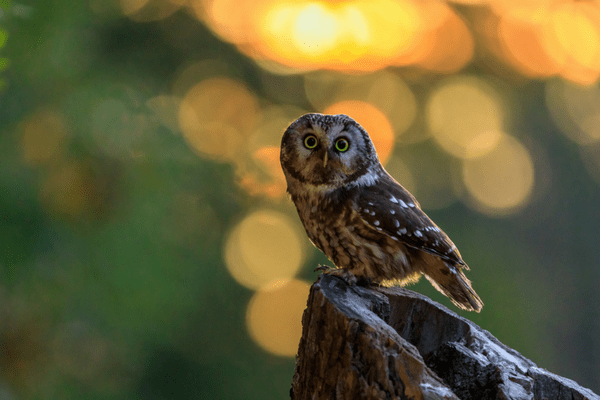
Where You’ll See Boreal Owls
For the most part, you will find boreal owls in deciduous forest habitats. They prefer forests that are filled with a wide array of tall trees including Spruce, Birch, and Pines.
They also like roosting within dense coniferous trees. These trees provide the small owls with protection against inclement weather. It also makes it much harder for predators to find and eventually capture them, which is a boon to their survival.
Boreal owl bird migration
Boreal owls do not migrate per se. But at times when food becomes scarce due to a lack of potential prey, they will become nomadic and move outside of their typical range or territory.
In North America, you can find boreal owls within the northern reaches in parts of Canada and Alaska. This owl also makes its home in the northern regions of Eurasia.
In the South part of North America, you can find the smallish owls in certain mountain ranges, but in particular the Rocky Mountains in the West. They also make their home in northern Minnesota too.
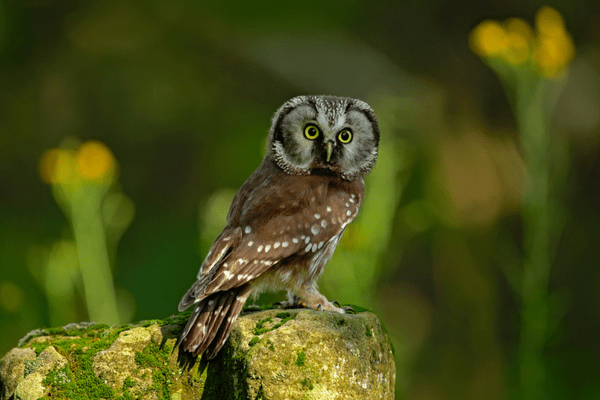
Boreal owl diet
As predators, the boreal owl will hunt small prey including insects, birds, and small mammals. In particular, you’ll find that their diet includes squirrels, mice, shrews, and voles quite regularly. They can find and hunt these small creatures easily as they remain low to the ground.
Boreal owls typically hunt at night. The only exception to this rule is when they live in the far north because the sun doesn’t actually set during the summer.
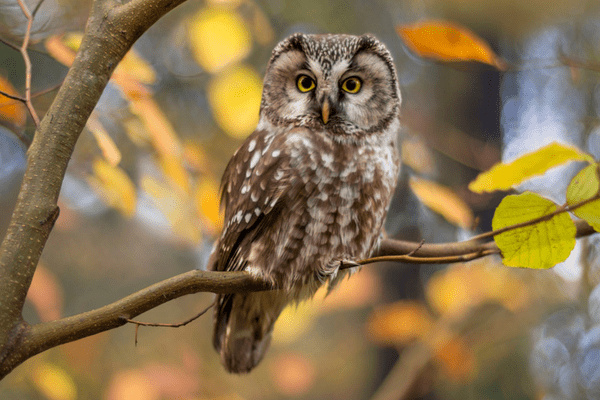
Boreal owl nesting
- Clutch Size: 2-9 eggs
- # of Broods: 1 brood
- Incubation Period: 26-32 days
- Nestling period: 27-36 days
- Egg Description: Dull white
Unlike many other birds, the boreal owl chooses to forgo building its own nest with sticks and other accumulated materials. As an alternative, the boreal owl likes to occupy the natural tree cavities or woodpecker holes left behind in trees.
In these tree cavities, the boreal owl will lay its eggs on the substrate that naturally occurs within the woodpecker hole or tree cavity. They aren’t against using man-made structures for their homes either. In fact, boreal owls are known quite well for using nesting boxes frequently, which is a great option to have if you’re attempting to attract them to your backyard.
Boreal owl behavior
Boreal owls have certain behavioral characteristics that make this particular bird quite special. These characteristics include:
- They remain far away from other owls and various creatures of the earth. They are not social creatures and prefer spending time alone. This is true even during the breeding season for the boreal owl.
- As a nocturnal creature, the boreal owl prefers to live its life during the night. It’s during the nighttime that you’ll find the boreal owl the most active.
- The boreal owl is a species that prefers to remain in its usual territory, so it isn’t a migratory bird. Although, occasionally when food sources are running dry or the weather gets particularly cold, you may find them moving south during autumn.
- Cavities carved into trees by woodpeckers are the preferred nests of the boreal owl. They are relatively small in stature, so they have no trouble fitting into these woodpecker-made tree cavities that they respectfully call home.
- This owl is known as a hunter that prefers to perch on branches that are low to the ground. Once they’ve located their prey, they will simply glide from their perch toward the ground and snatch up their prey within their talons.
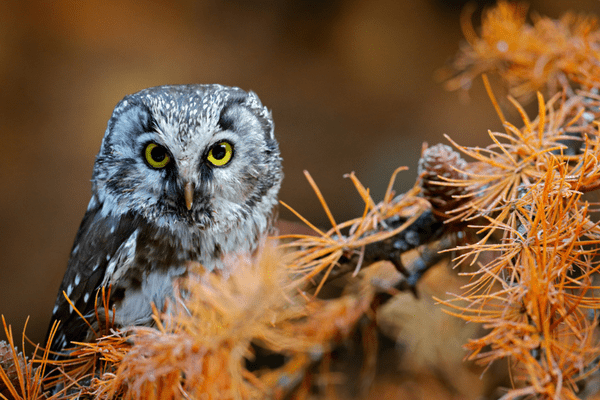
How-to attract boreal owls
Attracting these owls to your backyard might be a lot easier than you think. Some of my favorite tips include the following:
- Install nesting boxes in a secure location in your backyard. Make sure it’s high enough in the tree (20-30 feet) and that the nesting box is off the ground but still close enough to the ground for easy hunting.
- Avoid pruning the biggest tree branches in your trees. These make excellent perches for boreal owls that they will find very attractive. Leave these large branches to provide ample perching places for your fine feathered friends.
- Provide these owls with a birdbath. They aren’t the largest owls in the world, so the bath doesn’t need to be gigantic. It can be a relatively small birdbath that the boreal owls will use as a fresh source of water and a place to take a bath.
- If you have outdoor floodlights in your backyard, please keep them off or take them off of a timer. You do not want these lights going off late at night because it will scare away boreal owls. They do not like having artificial lights turned on in their territory or nesting ground, which would disrupt their nocturnal lifestyle.
- Mow the lawn in your backyard much less frequently. This creates much better hunting ground for these creatures because they hunt small prey including mice and voles. The long grass gives the small prey the illusion of security, which is great for the silent owl when it swoops down and catches these rodents and small mammals in its talons.
Boreal owl threats
The conservation status of this creature is Least Concern. This means that conservationists aren’t concerned about the population depletion of this owl. They currently have a large population that doesn’t appear to be dwindling anytime soon.
Boreal owl fun & interesting facts
- This owl is an incredibly secretive bird. it’s very elusive and it does a great job of remaining well hidden from potential predators. Since it’s such a small owl, it’s preyed upon by other owls and birds including Northern Goshawks, Cooper’s Hawks, Tawny Owls, Great Horned Owls, and other feathered predators.
- The binomial and genus names of this owl are very interesting indeed. The genus name stands for bad omen and the binomial name stands for the funeral. Basically, the scientific name of boreal owls is Aegolius funereus, which stands for bad omen funeral. One can only assume that their presence led to many deaths in the past.
- The female boreal owl is known as a hen, while the male boreal owl is known as a cock.
- Another name for this creature is Richardson’s owl.
- After the male boreal owl finds a nest during mating, he will call the female owl to let her know about his newest discovery.
- Male owls of this species are known for their beautiful singing voices. They sing in an effort to attract females. The female owl of this species, on the other hand, makes a relatively aggressive sound and it’s a lot less melodic than her male counterpart.
- Northern Saw-Whet Owl
- Northern Pygmy-Owl
- Spotted Owl
- Long-Eared Owl
- Burrowing Owl
- Western Screech-Owl
- Snowy Owl
- Barred Owl
- Eastern Screech-Owl
- Short-Eared Owl
- Elf Owl
- Northern Hawk Owl
- Great Grey Owl
- Flammulated Owl

